Higher Rates, Peak Margins, And How We're Allocating
Partner Content provided by The Lykeion
Anyone Out There Panicking?
During the first three weeks of the year, markets have seen their first meaningful correction since March 2020, after almost two years of a relentless surge higher.
The carnage has been most prevalent in the meme stocks of the past 18 months, SPAC names, and broader Tech, with extreme moves in Netflix and Peloton dropping more than 20%, Bitcoin losing half of its value in a couple of months (classic) and the ARK Invest flagship fund now worth less than half its February 2021 value (”Innovation isn’t linear” – Something Cathie Wood may say).
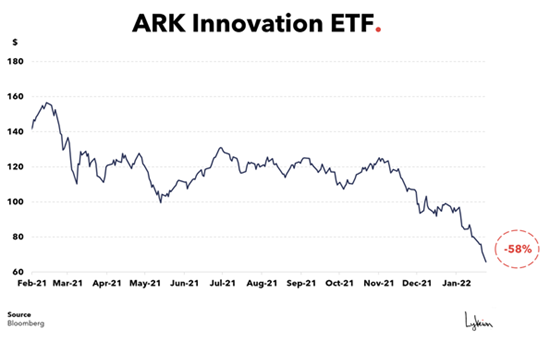
There’s a ton of anxiety in the market, and for good reason. The Fed’s hawkish stance (tapering QE and raising rates, effectively removing liquidity from the market), forced upon them in order to fight the highest inflation print in four decades, comes at a time when the economy is slowing (US Consumer Confidence is the lowest since 2008) and year-on-year comps are getting tougher.
To our readers who haven’t spent the last decade living and breathing financial media, you may be wondering, “Why are liquidity and low interest rates so important?” Because, as noted by our friend Bobby Vedral, it allowed the S&P 500 to close last year up 27% despite:
- COVID, PLFs and PCRs
- European Nat Gas priced 250% higher than at the beginning of the year
- China’s tech crackdown halving the value of Chinese Tech
- SPAC ETFs down 40% and retail darlings down 20%
- US Inflation reaching almost 7% whilst bond yields were less than a third of that
This is why the market reaction to this hawkish stance has, so far, been so dramatic (finance nerds are every bit as dramatic as the Kardashians – true story):
- 10-year bond yields have moved to the highest level since the beginning of COVID.
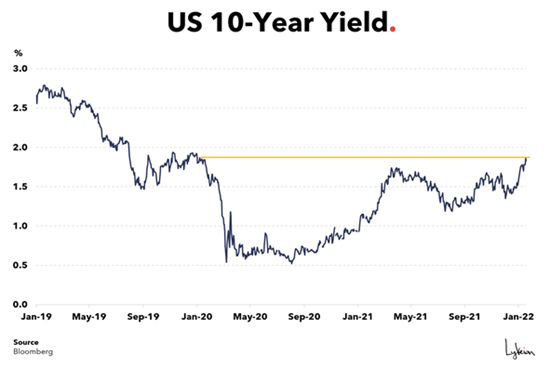
- The market is now expecting an extra 25 basis points rate hike versus Jan 1st, for a total of four hikes in 2022. For reference, in early Q4 2021, we were out there debating if there was going to be any hike at all.
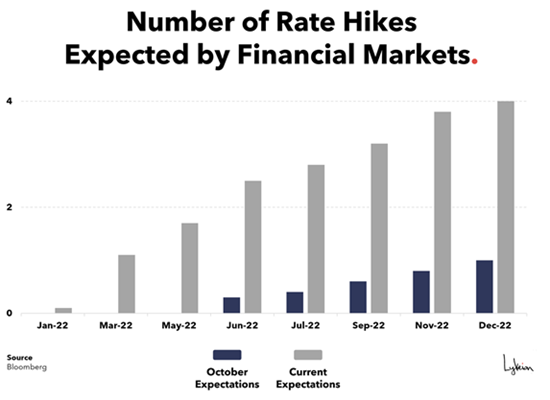
- Whilst the stock market tends to be the slowest to react to changes in economic fundamentals, the downward move has begun and headlines about the Nasdaq 100 (which includes the mega cap tech stocks) dropping 10% and entering correction territory have exploded.
But how relevant is all of this, really? Let’s take a step back:
- Despite the move higher, yields continue to be depressed, and well within the 40-years range of lower highs and lower lows. Real yields, which take into account the level of inflation, continue to be negative, just slightly less so. This is not a sign of a corrected market.
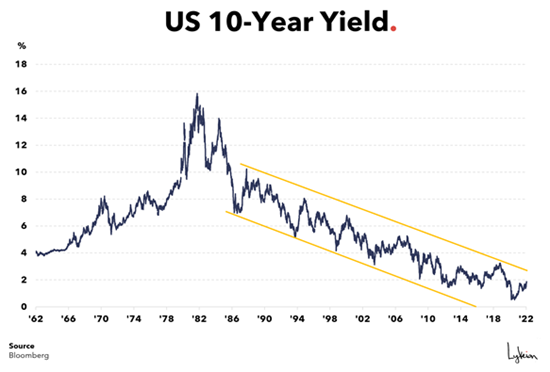
- Even if all four hikes where to materialize, this would mean that the top of the target range of Fed funds rates would still only be 1.25% - which, in historical terms, is very far away from being excessive, especially when we realize that the last time we saw this rate of inflation, the Fed’s base rate was significantly higher.
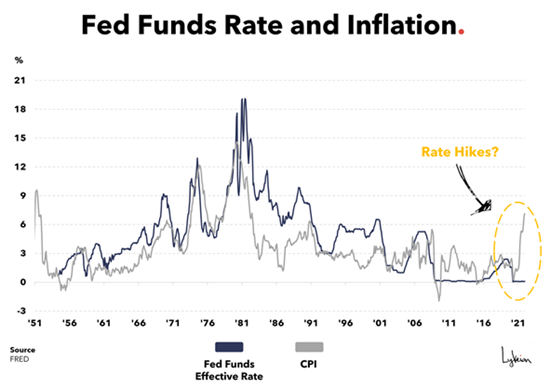
- As highlighted by Bloomberg’s John Authers, since the bottom in 2009, the NADSAQ 100 has registered 10 corrections of at least 10% and 2 bear markets of at least 20%, meaning that corrections seem to happen almost every year. But if you zoom out, these events are barely noticeable in the grand scheme of things, and one shouldn’t be overly dramatic about them (Damn Kardashians).
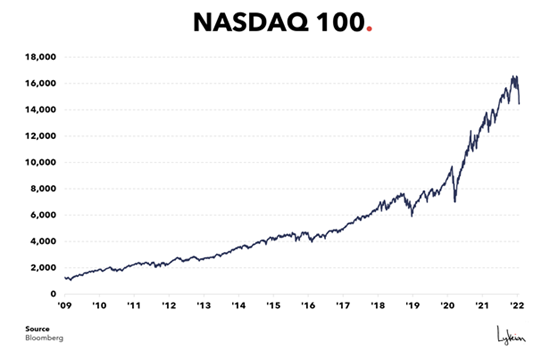
What all of this means, really, is that we’ve corrected very little still. Valuations are still through the roof, and there’s hell of a lot more downside in the market if the Fed chooses not to shy away from pushing a hawkish agenda (Volcker would be so proud). And whilst that’s a BIG IF (more on that later), we wonder: if we’d like to cry wolf, how big could the downside be? And what should we do, besides panic?
To answer that, we’ve outsourced investment strategy to Jeremy Grantham, founder of GMO (+$100 billion in AUM) and traditional value-oriented investor, who is of the opinion that:
- In the US we are in “the fourth superbubble of the last hundred years” (the others were the US in 1929 and 2000, and Japan in 1989).
- “Previous equity superbubbles had a series of distinct features that individually are rare and collectively are unique to these events. In each case, these shared characteristics [of superbubbles] have already occurred in this cycle”, meaning that the bear market should be imminent.
- We currently face the risk of “the largest potential markdown of perceived wealth in US history” - ($35 trillion, more than its annual GDP).
- If history is of any guidance and if this is the start of the crash, given that all bubbles in equity markets over the last 100 years have reverted back to trend, the S&P 500 could trend lower all the way down to 2,500 - 40% decrease from current levels (and 48% since last peak), which would be enough to get in the top 3 of Bear Markets, and give Michael Lewis a couple of more stories to tell.
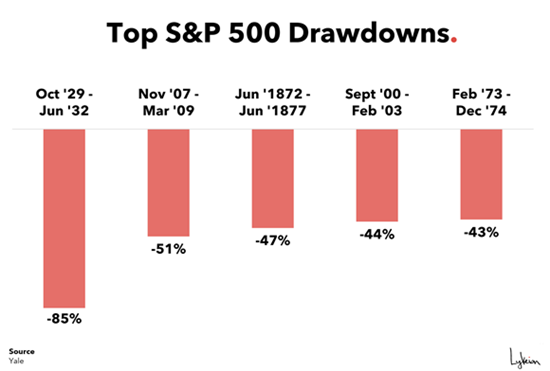
- Investors should avoid US equities and focus on non-US Value and alternative strategies (no Tim, leveraged VIX trades do not fall into this bucket). [Tim’s Note: Jokes on you, I have no more money to throw away on the VIX. RIP BTC. Only oil can save me now.]
Three Things to Keep an Eye Out For
OK, alright, stay calm. First of all, Jeremy Grantham was born in 1938 – which means that (1) he has a hell of a lot of experience, most of which he turned into financial success, but (2) he could easily be catalogued by venture capitalists and ARK believers as one of those white-haired investment managers who simply don’t get that this time might be different.
In fact, they could argue that all those numbers highlighted above are indeed cool stats, but they’re not telling us anything really new. We’ve been hearing about the bursting of the everything bubble for years now… and had we listened, we’d missed one of the most spectacular and synchronized stock market rallies in the history of markets.
So, as a way to avoid sensationalistic headlines, with the inspiration coming from the always mesmerizing Lyn Alden, here are the main questions we're asking ourselves before going out there with a party-pooper vibe.
Is the Fed going to increase interest rates to a level that will force a sustained market correction?
- Interest rates and market multiples have historically moved in opposite directions. Most of the growth in the US stock market of the past decade has mainly been explained by higher multiples (with the exception of a handful pandemic beneficiary high performers), so needless to say that higher rates are no bueno.
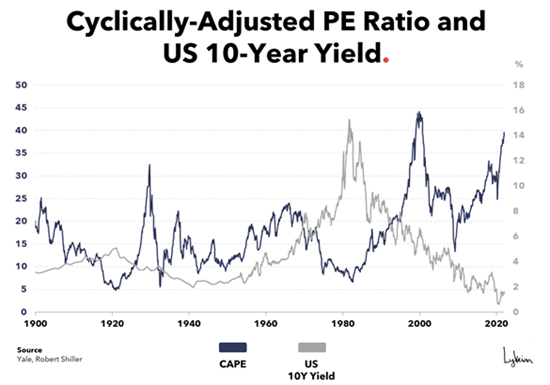
- What we need to remember is that a hawkish move requires a HUGE strength of character from Central Bankers in order to actually increase interest rates. They know that higher rates are going to tank the market, and that they will be subject to direct or indirect pressure from the top 10% of Americans who own 89% of the stock market and are therefore directly and disproportionately affected by the level and directional moves in rates.
- In fairness, this is not all Jerome Powell’s fault, but rather the group of Central Bankers that preceded him, and decided not to increase rates when it would have had a less severe market impact. This is precisely why Central Bankers have kept rates so low for so long (no one was really held accountable, and it was easier to kick the can down the road), and also why we’re still not convinced they’ll hike rates to levels that will cause a party-pooper scenario, despite the higher level of inflation (which will continue to be high, but probably not this high).
- Powell found himself in this position at the end of 2018, and he eventually backed down. We wonder: is inflation a force powerful enough to make him behave differently this time around? (*Hans Zimmer music ensues).
Have the dynamics around passive investing changed?
- Nope. Passive products have been the most important and consistent demand for US equities over the past decade, and whilst we may be approaching levels where passive alone can’t push the market higher, it sets a price-insensitive level of demand which will support markets, for better or worse, like an early 19th century catholic marriage.
Where are corporate profits, and corporate profit margins, going?
- If we make the case that the market still cares somewhat about fundamentals, margins are likely the key variable to look at.
- Taxation, amidst the growth of populist agendas, is one of the most significant areas of change. Effective corporate tax rates in the US have consistently come down over the last fifty years, from over 50% to 21%, and there’s plenty of popular arguments that politicians can make to see this going higher, especially after the explosion of corporate profits post COVID (after a decade of going nowhere), little of which has been shared with labour and instead leading to margin expansion (S&P 500 profit margin is now close to 13%, the highest ever).
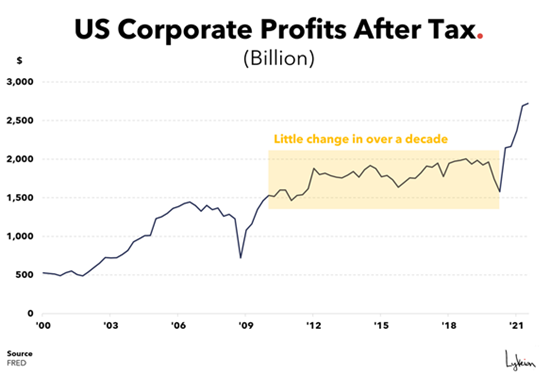
- Additionally, (1) many industries aren’t able to pass higher raw materials and labor costs onto the consumer (hits corporate margins); (2) if they’re able to pass it on, it leads to lower demand for most companies (hits revenue), unless they're selling virtue-signaling products (egos > inflation).
- In summary, higher taxes and a continuation of supply chain issues might lead to lower profits, which would mechanically lead to lower stock prices, unless the market continues paying higher multiples. After the past decade, that’s far from impossible.
What We’ll Focus On in 2022
We’ll avoid digressing too much on the rationale for each of these bullet points below (more on that in future pieces), but for 2022 we broadly think that:
- The risk of being exposed to the liquidity trade (long bonds, tech, private equity, ESG, most of crypto) given peak profit margins and hawkish environment is now significantly higher, and we might want to hedge our exposure or take some profits where we can.
- Real Assets continue to be our preferred theme: from commodities to real estate (selectively, and hopefully near a surfable beach) and some buckets of equities (significant preference for value over growth simply because it allows us to sleep at night, and we really like to sleep). This is a multi-year theme that will continue to play out.
- You know our view on Bitcoin, and broadly think that we should (1) only allocate money that, if we lose it, it won’t change our life (2) only think about taking profits when Tom Brady retires, or Tim stops trying to be a surfer.
- After the beating last year, Emerging Markets might bring some positive upside, especially if the US Dollar softens – but we need to know what we’re investing in, and that also includes an awareness of the local rule of law and of the “in between the lines” shenanigans of politics.
- We're avoiding leverage (please Tim, please) and bonds, we're being strategic about cash amidst an inflationary environment, and definitely avoiding being a protocol picker in the world of crypto – we either make it our full-time job or we won't try to play God in a world of atheists (we might have been reading too much Nietzsche).
**********
Diego Tremiterra is Co-Founder and Editor In Chief at The Lykeion
***
The views expressed in this article are those of the author and do not necessarily reflect the views of AlphaWeek or its publisher, The Sortino Group
© The Sortino Group Ltd
All Rights Reserved. No part of this publication may be reproduced, stored in a retrieval system or transmitted in any form or by any means, electronic, mechanical, photocopying, recording or scanning or otherwise, except under the terms of the Copyright, Designs and Patents Act 1988 or under the terms of a licence issued by the Copyright Licensing Agency or other Reprographic Rights Organisation, without the written permission of the publisher. For more information about reprints from AlphaWeek, click here.







